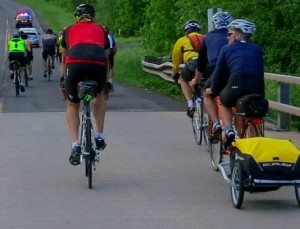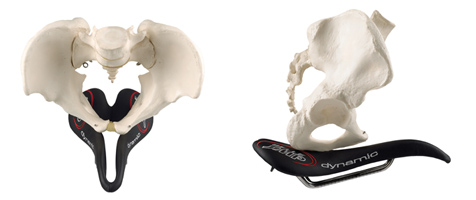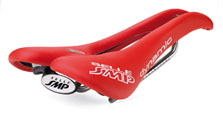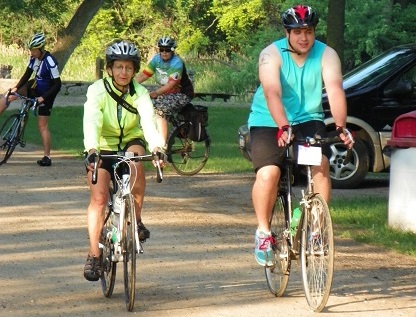From Salle, SMP
 For most cyclists, choosing a seat that fits their personal needs and prevents disturbances to the buttocks area is perhaps the most complicated component of the bicycle. Therefore finding a compromise is often the norm when finding the right seat fit. So let’s analyze the various elements at play and the possible solutions in order to provide you with some practical assistance that give more comfort and an enjoyable ride.
For most cyclists, choosing a seat that fits their personal needs and prevents disturbances to the buttocks area is perhaps the most complicated component of the bicycle. Therefore finding a compromise is often the norm when finding the right seat fit. So let’s analyze the various elements at play and the possible solutions in order to provide you with some practical assistance that give more comfort and an enjoyable ride.
Because of the anatomical complexities, were the seat meets the pelvis bones, that are rich in circulatory vessels and nerve endings, it is crucial to spend a little extra time to get a saddle that fits. Here personal fit is crucial as the pelvis bone and the musculature around it, like every other physical characteristic, is unique and specific to each individual (not even twins are absolutely identical).
Analyzing the pelvis structure and its interaction with the seat surface is important. The lower-back part of the iliac bone, together with the superior ramus of the ischium, bears the weight of the body in the normal sitting position. So let’s take a look at the photos, here to the right. It illustrates the ideal position of a pelvis on the seat: the area where the majority of the cyclist’s weight rests.
 Notice that the resting surface is therefore a few square centimeters in which there are bones, muscles, tendons and cartilage. During a normal bicycle ride these organs and structures are subjected to stress from prolonged compression and traumas from impact. Stress from prolonged compression may happen depending on the shape of the seat, how it interacts with the morphology of the pelvis and the type of padding it has. Traumas from impact: impact and danger are directly correlated with the absorption capacity of the padding, with the shape of the seat and the way it interacts with the pelvis.
Notice that the resting surface is therefore a few square centimeters in which there are bones, muscles, tendons and cartilage. During a normal bicycle ride these organs and structures are subjected to stress from prolonged compression and traumas from impact. Stress from prolonged compression may happen depending on the shape of the seat, how it interacts with the morphology of the pelvis and the type of padding it has. Traumas from impact: impact and danger are directly correlated with the absorption capacity of the padding, with the shape of the seat and the way it interacts with the pelvis.
Riding on a well-paved flat road leads the cyclist to constantly sit on the seat and a consequent prevalence of compression stress. On the contrary riding a mountain bike on a rough and uneven trail, with frequent sprints and technical descents, can lead to even violent impact even with less sitting on the seat.
 For these reasons Selle SMP recommends more padded saddles for off-road cycling (ex. BMX, cross-country, free ride, downhill, all mountain, etc.) and for all those specialties that involve jumps and stunts (street, urban, trial, etc.). In reality, according to our experts, using a seat with at least light padding is in any case always advisable. Seats with padding (but, not too much) are on average more comfortable and better absorb the roughness of the terrain, more effectively protecting the cyclist from the risk of micro traumas caused by the terrain and asphalt, both off and on road.
For these reasons Selle SMP recommends more padded saddles for off-road cycling (ex. BMX, cross-country, free ride, downhill, all mountain, etc.) and for all those specialties that involve jumps and stunts (street, urban, trial, etc.). In reality, according to our experts, using a seat with at least light padding is in any case always advisable. Seats with padding (but, not too much) are on average more comfortable and better absorb the roughness of the terrain, more effectively protecting the cyclist from the risk of micro traumas caused by the terrain and asphalt, both off and on road.
Apart from the type of cycling, numerous other factors must be considered when choosing the right seat. The athlete’s physical morphology, height, the interaxis/width of the ischial tuberosities, age, weight, pelvis conformation, which by correlating pants size to weight and height can be defined as narrow or normal or wide.
To properly adjust and support your seat model choice, see the video or see first-hand the many seat options at your local bike shop has.
Happy Riding!

